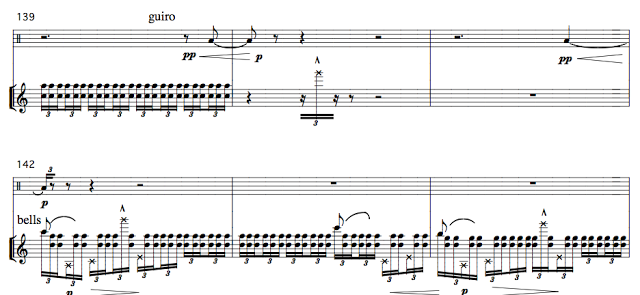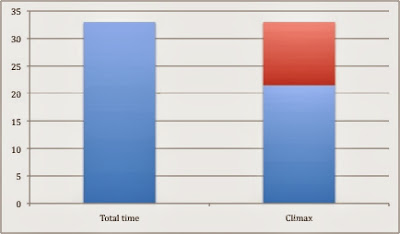UNPACKING DAVID LANG's "THE SO-CALLED LAWS OF NATURE" with SO PERCUSSION's Adam Sliwinski
Adam Sliwinski (percussionist, teacher, conductor, and member of the groundbreaking ensemble So Percussion), brings us this insightful, deep analysis of composer David Lang’s The So-Called Laws of Nature, which the group will perform this weekend at Zankel Hall. The evening, aptly titled American Patterns, sees So Percussion sharing the stage with fellow new music / electronica mavericks Matmos. Along with the Lang piece, the program includes three exciting new World Premieres: Bruce Dessner’s Music for Wood and Strings (commissioned by Carnegie Hall), Matmos’s own so-called remix, and a So Percussion/Matmos collaboration, Carnegie Double Music.
[line]
This is an incredible opportunity for any creative person to delve deep into the heart, breath, and bones of a contemporary piece of music – a journey akin to The Magic Percussion School Bus. The Operating System asked Adam to give our community a little synopsis of what they were about to read, and he offered the following:
This essay consists of analysis and commentary on a piece of music that is very special to me: the so-called laws of nature, by David Lang. My group So Percussion commissioned David to write this piece just a few years after we formed, and it was by far the biggest work written for us yet. At the time (2002), David had somewhat of a maverick reputation in the contemporary music field, owing to his rock-influenced aesthetic and bold ideas. He has since won a Pulitzer Prize and a faculty appointment at Yale, so what was once on the fringe is now more institutionally situated. Some of the analysis is fairly in-depth, but I think it should be accessible to curious readers, especially with the accompanying audio samples. (TheOS heartily agrees!)

[line]
[h6] TLP #6.371-6.372
The whole modern conception of the world is founded on the illusion that the so-called laws of nature are the explanations of natural phenomena. Thus people today stop at the laws of nature, treating them as something inviolable, just as God and Fate were treated in past ages. And in fact both were right and both wrong; though the view of the ancients is clearer insofar as they have a clear and acknowledged terminus, while the modern system tries to make it look as if everything were explained. [/h6]
[h6] TLP 6.52-6.521-6.522
…. There are, indeed, things that cannot be put into words. They make themselves manifest. They are what is mystical.
— Ludwig Wittgenstein, Tractatus Logico-Philosophicus [/h6]
The so-called laws of nature was written for So Percussion in 2002. When we premiered it at the Miller Theatre in October of 2002, I was 23 years old. To this date, it remains one of the most enigmatic, exhilarating, difficult and powerful pieces I’ve ever been involved with.
I believe that David is one of the most complex composers of our era.
That word complex, or complexity, is often used in music to describe a busy surface, or a highly developed compositional technique. David has both of these at times.
But complexity can also be found in the ineffable, the contradictory, and even in Wittgenstein’s mystical. I think David has deftly re-awakened this romantic notion, but without sentimentality or hubris.
After all, what is simple about Mozart’s short, homophonic Ave Verum Corpus? It is – to my ears – spiritually ambivalent, harmonically ambiguous, subdued. But there is no dense counterpoint or compositional dazzle.
Similarly, Lang’s little match-girl passion transfers the listener’s empathy from the usual figure of Jesus via the passion story – which a Jewish artist can hardly disassociate from the horrors of history – onto an anonymous pauper girl. David’s willingness to tackle this fraught religious and political history by making us feel empathy for the young girl is subtle, and extremely effective. It is a bold gesture: one which would have been shocking and blasphemous even 100 years ago, and still could be today if we paid close enough attention.
The so-called laws of nature tackles another sacred subject: the widespread assumption among educated people that humans will eventually be able to map reality through science. The piece presents a realm that at first seems rational: processes and forms unfold with aural transparency and systematic rigor. An eager student or performer may start analyzing and dissecting these structures, but will find that they do not always follow their own implied laws and behaviors.
In this article I’m going to unpack the so called laws of nature just a little bit. As with nature itself, I can only offer a window into its complexities, not describe it totally. After ten years and dozens of performances, I’m delighted to say that it still poses questions I cannot answer.
The Instruments
The so-called laws is written for percussion quartet, which actually means “either an acknowledged percussion instrument or something you make yourself.”
In this case, most of the instruments are homemade or found. Certain specific guidelines are given, while some amount of variation is allowed and expected.
The first movement is for 7 woodblocks in each setup. No pitches are specified, but there is a fascinating tuning scheme: the top three blocks on every player’s instrument are exactly the same, with each block tuned progressively lower down the line. Player 1 has the highest blocks 4-7, while player 4 will have the lowest.
We play the first 222 bars in complete unison. The music looks, and sounds, like this:
But when I say “complete unison,” remember that the woodblocks (actually slats of walnut in our version) are not tuned in absolute unison. This means that the top three notes you see – treble clef D, F, and A – are the same pitch, but each progressively lower note will sound as a complex chord which spreads wider apart the lower it is.
If you count notes in this opening passage, you’ll notice that only six appear. That’s because Lang delays the arrival of the most extreme low chord until almost the end of the section, in bar 203:
The very nature of the instrument built for this movement determines its sonic and structural characteristics. Reading the score doesn’t necessarily give you that information – it just looks like a stream of linear notes.
In the second part of the first movement, the tuning scheme allows the compositional texture to be flipped on its head. Lang switches the main activity to the low blocks, with high blocks peeking out as accents. This means that the churning activity in the low blocks is harmonically muddled and complex, while the high accented blocks are perfectly unison.

[spacer]
The second movement divides the players between homemade metal pipes and more traditional percussion instruments: tom-toms, bass drums, and brake drums.
The metal pipes depart from the woodblocks of the first movement in that they are tuned to specific pitches: F, Ab, C, Db, F, G, Ab. Each musician has the same pitches in the same register. They all play the same material, but in a constantly shifting series of four part canons that strain the capacity of the performers.
In the third movement, Lang calls for tuned flowerpots, teacups, woodblocks, little bells, and guiro.
Most of the instruments in this movement function the way percussion instruments often do: they fulfill gestural and rhythmic functions.
But the flowerpots are tuned to – which usually means “found at” – very recognizable and diatonic pitches. They undulate a steady chorale throughout the movement, the only real gesture in the entire piece that could be labeled “post-minimalist.”
Though they are notated and played as quick rhythmic figures, the effect is a smooth, sustained harmony.

[spacer]
One could conceivably play this chorale on many different instruments, but there is a fragility and an earthy quality to flower pots that cannot be replaced. It would not be the same on any other instrument. Though the performer must concentrate on a very difficult sequence of notes, the aesthetic effect is delicate, sad, interminable.
Process and expectation
I.
[h6] I am interested in perceptible processes. I want to be able to hear the process happening throughout the sounding music.
To facilitate closely detailed listening a musical process should happen extremely gradually.
— Steve Reich, Music as a Gradual Process I. [/h6]
Try an exercise: Pasted below are the first 33 bars of the third movement of the so-called laws.
The x’s on the bottom are the teacup melody, from low to high. Observe the behavior of the teacups in the even numbered bars (2, 4, 6, etc). By “behavior” here I mean only where in the bar the notes are placed, and where they seem to move in the next. See if you can figure out the rules for how these three notes are allowed to behave.
Does one have agency, i.e. can it act first? Does it have limitations? Do any of its behaviors influence or cause the others to change?
I’m not going to give you the answers, because if you’ve actually made it this far into the article you’re hardcore enough to figure it out.

[spacer]
This evolving teacup melody is a great example of Steve Reich’s “music as a gradual process.” It has mathematical complexity, and is very cleverly constructed…but you can also easily hear during the first listen that something is changing.
Process has been around forever in music composition. “Gradual process” has been around at least for the 900 years since Leonin and Perotin wrote choral pieces that required 12 minutes to sing two words.
A gradual process is a great way to construct expectations. Satisfying or thwarting those expectations is one of the composer’s sharpest tools, just as Mozart used tonal expectations to sculpt his dynamic sonata forms.
For most of the 20th century, composers in the European classical tradition searched for new – or at least refreshing – ways to build structure in music. Let’s keep in mind that that the “tonal” period that most orchestra and instrumental repertoire comes from only held together for about 300 years.
Composers like Francesco Landini in the 1300’s had very little use for triads except as the happy result of polyphony, and certainly not to resolve a phrase: for that he jumped away from the leading tone (ti) down to the sixth degree (la), then jumped back up to the first, with a nice open fifth or octave resolution. By the time of Bach’s practice, this way of coming to a cadence was unthinkable.
Minimalists like Reich and Glass toyed around with the old structural technique of building compositions very gradually. The advantage of doing this is that when you want something to change, very small variations are quite audible.
In the 3rd movement of so-called laws, David creates a counterpoint of processes. The teacup melody is the first one. Soon, little bells and woodblocks each proceed at their own pace through similar journeys, all managed by the performers’ linear dance while the teacups continue to spin along.
In a composition for quartet, you might expect any complicated layers to appear as distinct voices. In movement 3 of the so-called laws, what you have instead is all four percussionists playing in unison, with only a split flowerpot voicing to distinguish them. This is a strange conceit, especially if you imagine any string quartet doing the same thing.
The second movement combines very satisfying gradual processes with much smaller ones. The very opening bars state the thesis of the entire piece: expansion and contraction.

[spacer]
This accordion-like gesture continues to build in ever-growing layers of complexity throughout the movement.
It echoes both the motion of the teacup melody from the 3rd movement and the accelerating/decelerating rhythms of the 1st movement.
These are actually very brief processes, concise enough to count as motives.
The gradual process occurs through a slow accumulation of melodic material. The seven pitches of the tuned metal pipes are introduced slowly, where their own expanding and contracting behaviors begin to collide with the pitches that have already been introduced.
Here is the entrance of the Ab’s, the first to be added after the low F. Start following just the Ab’s from measure 24. Look familiar?
 [spacer]
[spacer]
Mind boggling complexity? Check. Significant events that audibly mark the structure and build momentum? Also check.
As that momentum builds, the melodic tapestry eventually encapsulates all seven pitches, with the entrance of the 3 highest notes marking the halfway point of the pipe music.
II.
I once emailed Steve Reich about something that was troubling me in his seminal piece Drumming. I had been touring and teaching the piece a lot with So Percussion, and was puzzled by the patterns at the end. Instead of repeating exactly the same motives at a different rhythmic interval, he left a note out of each final pattern.
I don’t have the email anymore, but it went something like this:
[line]
Me: “Hi Steve, I wanted to know if there’s a mistake at the end of Drumming in the score. Players 7-9 each have one fewer note than the players that have already built their patterns.”
Reich: “No, it sounds much better that way, don’t you think? It’s too heavy if you put in the whole pattern!”
[line]
As a young player, this melted my brain.
After all, “Music as a Gradual Process” had said nothing to the effect of “change stuff whenever it sounds better.” I imagined that a monolithic statement like Drumming would require some kind of dogmatic purity in its execution.
As young(er) thinkers, we want the world to make sense. We consume knowledge in the hope that it will reveal some kind of consistent plan.
As music students, we eagerly dissect the scores of the masters looking for that unity. We read entire textbooks that try to show us Beethoven really just meant “mi-re-do.”
Great artists embrace the complexity – there’s that word again – of life.
One of the most penetrating ideas in the so-called laws occurs in the third movement. As I explore below, the movement is perfectly symmetrical in form. But there is a hitch, a guiro that interrupts the smooth flow of the interminable flowerpot chorale.
After the first half is over, the piece feels like it could be complete. Actually, applause often erupts during the silence before the second half. That it does is a testament to the cohesion of Lang’s form. The guiros scrape out of the silence into the second section.
At the realization that the movement is only half over, some are delighted, others probably dismayed. We know that the process takes awhile – about six minutes – to cycle through.
Our expectations of a monotonous repetition are thwarted, devastatingly so. In addition to the woodblocks that now chirp a new process on top of everything else, the guiro becomes an insistent noise, disruptive and crass.
Right before the bells enter, the guiro actually succeeds in abolishing all of the old elements: only it and the woodblock remain for two measures. Only it gives permission for them to return after the silence.
Crucially, the guiro has the power to disrupt the process completely Although the only other new element (woodblock), keeps chirping along, all of the other elements that have been moving steadily for 8 minutes are silenced and halted.

[spacer]
Finally, the guiro has the last word, eventually silencing the melancholy chorale that preceded it.
Even as I write this, I marvel that such a simple, noisy thing as a guiro scrape can stimulate such interpretive reflection. It is one of David’s true gifts as a percussion composer.
Symmetry and form
I like graphs. Especially when they show me something useful.
On the micro scale, the so-called laws manifests extremely subtle and complex processes. On the large scale, its structures are symmetrical, sometimes even obvious.
Below is a graph of the number of measures in the piece by movement. Each is split almost exactly in half. In the first movement, the material changes noticeably from first to second part. In the second and third movements, the music from the first half repeats verbatim, though with important differences.
Tapping into the theme of gradual process, this literal repetition seems to go against the tradition of “developing variation” that permeates much of western music. It’s acceptable to bring an idea back, but it should be couched in some sort of variant: either a different key area or other substantial alteration.
Actually, he does just that, although the cut and paste method of bringing the entire first half material back seems contrary. He achieves it by adding other processes in simultaneously.
The second half of the second movement cycles right around to the beginning of the pipe music, but with a significant new element: drums. They enter one at a time down the line, at exactly the same point as each of the new pipe pitches, unfolding their own expanding and contracting processes.
Part of the extraordinary difficulty of playing this movement is that the performer must juggle multiple processes at the same time, which have nothing to do with each other. They display the same characteristics, but do not line up in a predictable way, which means they must be practiced for a very long time.
Here’s an excerpt from my part. I’ve already explained the general behavior of the pipes, so look closely at the drums. Actually, it’s quite simple, and closely resembles the behavior of the teacups in the third movement:


It might have seemed from the graph that the first movement is gargantuan, while the last is tiny. In fact, each movement progressively compensates for having fewer measures by also having a slower tempo.
Below is a graph of the actual amount of time each section of the piece occupies in our recording. It’s immediately obvious that the 6 sections of this piece balance each other out with almost perfect symmetry and evenness.
There is one element in this piece that doesn’t insert itself logically according to the bi-fold symmetry of each movement: the climactic entrance of brake drums and bass drums in the second movement.
Undoubtedly, this is the climax of not just the second movement, but of the entire piece. It arrives at measure 537 out of 620, 85% of the way through the movement. In the context of the whole piece, it occupies a different position.
The graph below shows where that moment happens in the timing of the recording. The proportion of the first part of the whole work to the second according to this split hews very closely – though not perfectly – to the famous “golden section.”
In my view we sometimes get over-excited about the golden section. It’s amazing, to be sure, but the general proportional area it represents just happens to be a very good place to build a climax.
I’m not convinced that David consciously planned it that way. I think he just has a great ear for musical structure.
This incredible moment is the lynchpin of macro-structure for the entire piece. Without it, the so-called laws is a fantastic symmetrical study of musical processes. With it, the piece achieves a visionary wholeness that is the hallmark of any great symphony or sonata.
Drama
Here is a video of So Percussion playing the second movement of the so-called laws.
One of the trademarks of this movement is the way we stand in profile, with each player’s back to the others. In this way it resembles a bass drum line from a marching drum corps.
This is certainly not the easiest way to play it.
When we first got the piece, we set the second movement up in a natural arc. That way, we could see and hear each other most easily: as the first player, I keep tabs on each other player as the canons cascade inexorably down the line.
David wasn’t satisfied with the convenience of this setup. He wanted his gradual processes to be not only well played and aurally satisfying, but visual striking as well.
He asked us to make this profile line, where I can’t see anybody at all! This means that not only is it harder to play together, but I have a difficult time distinguishing who is playing what behind me.
A large chunk of the first and third movements – actually all of the third – are in unison. Theoretically, so is the second movement, but we are offset in canons the whole time. By facing down the line to the side of the stage, the audience sees our mallets activate like pistons in a machine, always 1234 1234.
When the drums come in halfway through, their individual processes are just as visually transparent, because each performer’s left hand is easy to follow. When the drums come into climactic unison, their visual consonance is extremely dramatic against the still-churning 1234 of the pipe canons.
David’s sense of the theatrical is highly developed in his percussion works. Rather than hide the physicality behind the orchestra, he seeks to accentuate it. What I find so thrilling is that this physicality serves more to highlight the processes and laws of his compositional universe than the personal expression of the performers.
In this sense, he doesn’t indulge in the sentimental with his subject. I don’t interpret the so-called laws as an emotional reaction against the rationalism of the scientific worldview. Actually, it’s a celebration of it, but with a humble and mischievous acknowledgement that still greater mysteries lie behind the patterns.
[line]
Finally, here are David’s program notes about the piece:
[articlequote] I went to college to study science. I was expected to become a doctor, or at the very least a medical researcher, and I spent very much of my undergraduate years studying math and chemistry and physics, hanging out with future scientists, going to their parties, sharing their apartments, eavesdropping on their conversations. I remember a particularly heated discussion about a quote from Wittgenstein: “At the basis of the whole modern view of the world lies the illusion that the so-called laws of nature are the explanation of natural phenomena. ” This quote rankled all us future scientists, as it implied that science can’t explain the universe but can only offer mere descriptions of things observed. Over the years it occurred to me that this could be rephrased as a musical problem. Because music is made of proportions and numbers and formulas and patterns I always wonder what these numbers actually mean. Do the numbers themselves generate a certain structure, creating the context and the meaning and the form, or are they just the incidental byproducts of other, deeper, more mysterious processes? My piece The So-called Laws of Nature tries to explore the “meaning” of various processes and formulas. The individual parts are virtually identical-the percussionists play identical patterns throughout, playing unison rhythms on subtly different instruments. Most of these instruments the performers are required to build themselves. Some of the patterns between the players are displaced in time. Some are on instruments which have a kind of incoherence built into their sound. Does the music come out of the patterns or in spite of them? I am not sure which, but I know that this piece is as close to becoming a scientist as I will ever get. [/articlequote]
The wonderful percussionist, scholar, and videographer Ross Karre, emailed Adam an extremely thoughtful and interesting response after the article was posted at Adam’s blog:
Adam, thanks for this article. It’s extremely valuable. I have a couple of questions that also come from former (and maybe also future) students who are interpreting Lang’s music alongside numerous other composers:
When you say, “Even as I write this, I marvel that such a simple, noisy thing as a guiro scrape can stimulate such interpretive reflection. It is one of David’s true gifts as a percussion composer.” Actually, is this not your gift as a creative sound maker? Is David’s gift not one of leaving blanks in his music for you to fill? Students ask me what to do with the “missing” dynamics and nuance (phrase markings) in Lang’s music. I tell them that the dynamics may not be missing. Who required them to be there in the first place? Dynamics (volume, amplitude, nuance) are the responsibility of the performer. The same goes for your guiro sound. If this was David’s gift, he would have required gourd vs. plastic, thin stick vs. thick, large grooves vs. tight. Instead, he knows that you will think about those features of your sound makers with much more depth and experience than most ever could. I think that’s a special aspect of writing for percussion that David understands. Who determined the diameter of your pipes? Conduit or schedule 40? Mount them on the nodes or on foam? These are decisions that every student has to grapple with, of course. What I find most interesting about being a percussionist is the obligation to grapple with these decisions each and every time we learn a new piece. In a sense, our gift is anti-codification. Every young percussion group can watch the Vic Firth video and then mount their similarly sized pipes in the same way. Or, they can re-engage those decisions that you made as the premiering ensemble in order to discover something new and personal. In a sense, this is the complexity of percussion music by David Lang and others who choose to leave countless parameters up to the performers.
But the concept of complexity seems to carry a defensive tone as I read your words. It seems as if you might be showing us how complex the results of David’s music are for the sake of defending it against other music which (problematically) allies itself with a movement grounded in complexity (or, even worse, names its school of composition with the words [new] complexity). I think the issue here is one of “input” and “output”. In your quote of Steve Reich, you noted his desire for palpable process. To do this, he suggests that processes should manifest slowly so that they can be recognized and analyzed (perceived and experienced) extemporaneously. Therefore, the “input” of the performer (and their knowledge of the processes indicated in the score) and the “output” of the ensemble to the audience (and their varying awareness for the score’s instructions, concept, and structure) are closely matched. In So Called Laws, a similar input to output ratio is established but indeterminate complexity also enters the equation allowing for unexpected complexity to join (and blur) the output. The constructive interference of the pipes and pot tones, the reverberation of the sounds in the space, the juxtaposed nuances of four individual phrase shapes, etc. all contribute to variables that are not explicitly notated in the input but are allowed to exist in the output and, as you say, contribute to a highly-complex result. The way in which composers in the new complexity school achieve this is by controlling many more of the parameters in the notation itself. This creates a situation where the input from the composer+interpreter side of the stage is quite different from the output to the audience. That relationship is (perhaps purposefully) obfuscated such that extemporaneous recognition of the score’s process(s) isn’t palpable. While the similarities of complexity-resulting-from-simple-instructions vs. complexity-resulting-from-densely-layered-instructions may be numerous, the differences in the directness of communication couldn’t be greater. I’ve always wanted to reconcile the baggage associated with the terms modernism and minimalism by highlighting the non-qualitative distinction of directness of communication. Your article serves as a perfect prompt for this because it highlights the value of direct communication and its unpredictable and complex manifestations. In other words, if a composer wants the audience to understand what they’re trying to say/do, great! If another composer wants to say one thing but have the results interpreted in myriad ways, that’s also great! Even better, both can be combined to great effect! Perhaps it’s then possible to discontinue the futile attempts to defend modernism against minimalism and vice versa (as Kyle Gann and John Adams seem eager to do). This article prompts composers to stop their obligation to defend simplicity for simplicity’s (or accessibility for accessibility’s) sake and instead acknowledge the virtues of a richer approach to composition. In this environment of an acknowledgement (and preference) for the (in)directness of one’s communication as a composer, a program of Alvin Lucier, Steve Reich, and Peter Ablinger makes perfect sense. I would like to see that concert, in fact. -Ross Karre
Adam also sent the article along to David (Lang), and here’s what he said.
yes, it is really clear I worked really hard on ‘so called laws’ to make a great piece – thanks for noticing! but I couldn’t have done it without you. there is that line in ross’ response where he challenges your idea of what my ‘special gift’ is as a percussion composer. my ‘special gift’ is writing a kind of music that has room for you, personally, to add your ‘special gift.’ it has always fascinated me that bach’s most brainy, most architectural, most speculative pieces have no markings to guide you in their performance. people sometimes think that this must mean that they were meant as thought exercises, or not really meant to be played in public. I think the truth is that a piece like the ‘well tempered clavier’ presents a perfect world that is larger than what any one individual can see in it. including bach himself. to mark it or over-specify it would be to preference one way of seeing it over all others, thus violating the universality of its scope. -David Lang
…and here’s Adam’s response to Ross (and David):
One of the things Ross and David both notice is that I might be focusing too much on the brilliance of the score without emphasizing that the performer’s input is part of the brilliance.
On the whole, I think this is valid, and probably just a self-deprecating blind spot on my part.
Specifically with regard to the guiro, I do have a sense that simply writing for guiro the way that it’s done in the context of the flowerpot movement has a clear narrative purpose and effect that I attribute to David’s design. The flowerpots must float continuously; a guiro must interrupt with some sort of a scraping sound, no matter what choices the performers make.
I don’t disagree with Ross. His main point in this regard is that David trusts us to help the guiro fulfill its function by choosing the right one and finding the right way to insert it.
David makes this point himself, and I think it’s a wonderful emphasis to add to my commentary. I just want to give David credit where I believe it is due.
A whole other article could (and maybe should) be written about the development process for this piece. I can’t believe how many folks opened it after I posted! Ross and David’s point holds very strongly when you explain how collaborative the process of was. The decision to use raw walnut slats instead of woodblocks, the type of pipes for the second movement, the distribution of glock bars and crotales, and the flowerpots were all decisions we were extremely involved in, if not ones we outright made.
Ross is correct in emphasizing that our decisions with regard to instrumentation can be a reference point, but should not codify a definitive practice! The music is meant to have variability through different groups. I didn’t really emphasize this in the article. The tuning scheme in the first movement is brilliant largely because it will still hold the structure of the movement, even if a different group uses a wildly different kind of wood/woodblock.
Ross senses a defensive tone in my treatment of the theme of “complexity.” I certainly didn’t think of it that way as I wrote it. I share the values he expresses of wanting to look to deeper connections and leave the old arguments behind.
Actually, I was hoping to do just that with this article! My intention is to allow the idea of the “complex” to breathe and have the kind of variability and nuance that the word itself actually has.
My favorite line in Ross’ response is this one: “I’ve always wanted to reconcile the baggage associated with the terms modernism and minimalism by highlighting the non-qualitative distinction of directness of communication.”
I’ve thought along these lines for a long time, but Ross has really put it together well.
Actually, the more I learned about 20th century composers like Ligeti, Xenakis, Reich, Lang, the more I thought they were all aiming at the same thing. Each explores the realm of micro/macro, as well as the balance of direct/indirect communication. In my graduate thesis, I explored how Xenakis’ micro structures in Pleiades are sometimes indecipherably complex – since they are often an output of stochastic processes, there’s not always something to “cipher” anyway – while many of the macro structures can be mapped into beautiful arcs and highly pleasing symmetries.
Truly brilliant composers like these can manipulate multiple levels of micro/macro, and multiple levels of directness, without being dogmatic in any direction.
What indirectness could a Reich piece have? Drumming, in fact, encapsulates much complexity of possibility within its resultant patterns, but he chooses to expose the entire process at once instead of winnowing down to one pattern for the listener. Even the most obviously direct gestures are subtly indirect, such as the very first “downbeat” of the piece, which is no such thing.
[box] BIO: Adam Sliwinski has built a dynamic career of creative collaboration as percussionist, conductor, and teacher. He specializes in bringing composers, performers, and other artists together to create exciting new work.
A member of the ensemble So Percussion (proclaimed as “brilliant” and “consistently impressive” by the New York Times) since 2002, Adam has performed at Carnegie Hall, the Brooklyn Academy of Music, The Lincoln Center Festival, Stanford Lively Arts, and dozens of other venues in the United States. In that time, So Percussion has toured Russia, Spain, Australia, Italy, Germany, and Scotland. He has had the opportunity to work closely with Steve Reich, Steve Mackey, Paul Lansky, David Lang, Matmos, Dan Deacon, and many others.
Adam is one of only a few percussionists ever to complete the Yale School of Music’s Doctor of Musical Arts program, where his thesis engaged the percussion music of Iannis Xenakis. He also earned his Masters at Yale with marimba soloist Robert Van Sice, and his Bachelors at The Oberlin Conservatory of Music with Michael Rosen. He currently teaches percussion at the Bard College Conservatory of Music, and was a Visiting Lecturer at Princeton University in 2011-2012, where So Percussion was ensemble-in-residence. [/box]
We previously profiled So Percussion in celebration of another staggeringly adventurous evening at Carnegie Hall, back in March of 2012.








